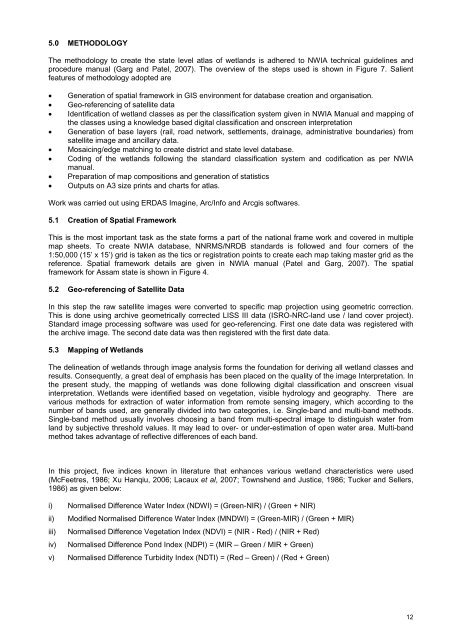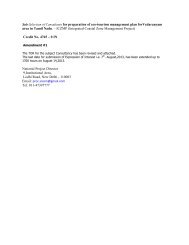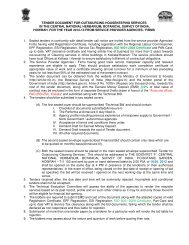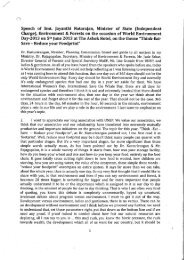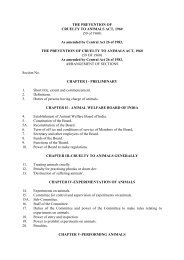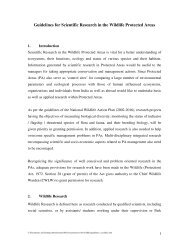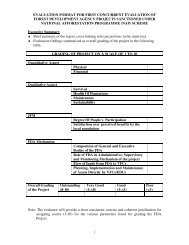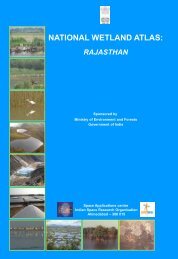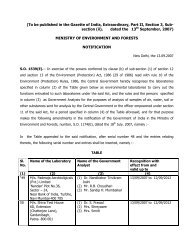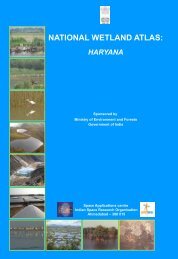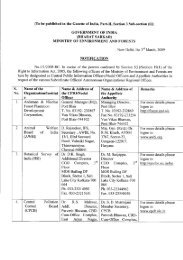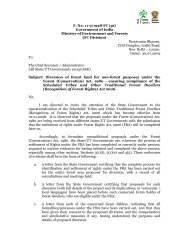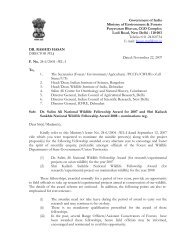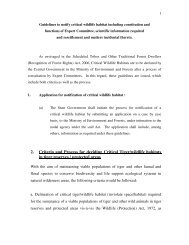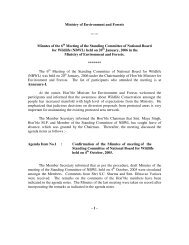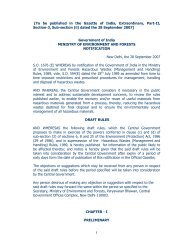Assam - Ministry of Environment and Forests
Assam - Ministry of Environment and Forests
Assam - Ministry of Environment and Forests
You also want an ePaper? Increase the reach of your titles
YUMPU automatically turns print PDFs into web optimized ePapers that Google loves.
5.0 METHODOLOGYThe methodology to create the state level atlas <strong>of</strong> wetl<strong>and</strong>s is adhered to NWIA technical guidelines <strong>and</strong>procedure manual (Garg <strong>and</strong> Patel, 2007). The overview <strong>of</strong> the steps used is shown in Figure 7. Salientfeatures <strong>of</strong> methodology adopted are• Generation <strong>of</strong> spatial framework in GIS environment for database creation <strong>and</strong> organisation.• Geo-referencing <strong>of</strong> satellite data• Identification <strong>of</strong> wetl<strong>and</strong> classes as per the classification system given in NWIA Manual <strong>and</strong> mapping <strong>of</strong>the classes using a knowledge based digital classification <strong>and</strong> onscreen interpretation• Generation <strong>of</strong> base layers (rail, road network, settlements, drainage, administrative boundaries) fromsatellite image <strong>and</strong> ancillary data.• Mosaicing/edge matching to create district <strong>and</strong> state level database.• Coding <strong>of</strong> the wetl<strong>and</strong>s following the st<strong>and</strong>ard classification system <strong>and</strong> codification as per NWIAmanual.• Preparation <strong>of</strong> map compositions <strong>and</strong> generation <strong>of</strong> statistics• Outputs on A3 size prints <strong>and</strong> charts for atlas.Work was carried out using ERDAS Imagine, Arc/Info <strong>and</strong> Arcgis s<strong>of</strong>twares.5.1 Creation <strong>of</strong> Spatial FrameworkThis is the most important task as the state forms a part <strong>of</strong> the national frame work <strong>and</strong> covered in multiplemap sheets. To create NWIA database, NNRMS/NRDB st<strong>and</strong>ards is followed <strong>and</strong> four corners <strong>of</strong> the1:50,000 (15’ x 15’) grid is taken as the tics or registration points to create each map taking master grid as thereference. Spatial framework details are given in NWIA manual (Patel <strong>and</strong> Garg, 2007). The spatialframework for <strong>Assam</strong> state is shown in Figure 4.5.2 Geo-referencing <strong>of</strong> Satellite DataIn this step the raw satellite images were converted to specific map projection using geometric correction.This is done using archive geometrically corrected LISS III data (ISRO-NRC-l<strong>and</strong> use / l<strong>and</strong> cover project).St<strong>and</strong>ard image processing s<strong>of</strong>tware was used for geo-referencing. First one date data was registered withthe archive image. The second date data was then registered with the first date data.5.3 Mapping <strong>of</strong> Wetl<strong>and</strong>sThe delineation <strong>of</strong> wetl<strong>and</strong>s through image analysis forms the foundation for deriving all wetl<strong>and</strong> classes <strong>and</strong>results. Consequently, a great deal <strong>of</strong> emphasis has been placed on the quality <strong>of</strong> the image Interpretation. Inthe present study, the mapping <strong>of</strong> wetl<strong>and</strong>s was done following digital classification <strong>and</strong> onscreen visualinterpretation. Wetl<strong>and</strong>s were identified based on vegetation, visible hydrology <strong>and</strong> geography. There arevarious methods for extraction <strong>of</strong> water information from remote sensing imagery, which according to thenumber <strong>of</strong> b<strong>and</strong>s used, are generally divided into two categories, i.e. Single-b<strong>and</strong> <strong>and</strong> multi-b<strong>and</strong> methods.Single-b<strong>and</strong> method usually involves choosing a b<strong>and</strong> from multi-spectral image to distinguish water froml<strong>and</strong> by subjective threshold values. It may lead to over- or under-estimation <strong>of</strong> open water area. Multi-b<strong>and</strong>method takes advantage <strong>of</strong> reflective differences <strong>of</strong> each b<strong>and</strong>.In this project, five indices known in literature that enhances various wetl<strong>and</strong> characteristics were used(McFeetres, 1986; Xu Hanqiu, 2006; Lacaux et al, 2007; Townshend <strong>and</strong> Justice, 1986; Tucker <strong>and</strong> Sellers,1986) as given below:i) Normalised Difference Water Index (NDWI) = (Green-NIR) / (Green + NIR)ii)iii)iv)Modified Normalised Difference Water Index (MNDWI) = (Green-MIR) / (Green + MIR)Normalised Difference Vegetation Index (NDVI) = (NIR - Red) / (NIR + Red)Normalised Difference Pond Index (NDPI) = (MIR – Green / MIR + Green)v) Normalised Difference Turbidity Index (NDTI) = (Red – Green) / (Red + Green)12


